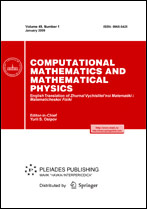|
|
Zhurnal Vychislitel'noi Matematiki i Matematicheskoi Fiziki, 2007, Volume 47, Number 4, Pages 717–737
(Mi zvmmf308)
|
 |
|
 |
This article is cited in 18 scientific papers (total in 18 papers)
Dynamically adapted grids for interacting discontinuous solutions
P. V. Breslavskiy, V. I. Mazhukin
Institute of Mathematical Modeling, Miusskaya pl. 4, Moscow, 125047, Russia
Abstract:
Further development of the dynamic adaptation method for gas dynamics problems that describe multiple interactions of shock waves, rarefaction waves, and contact discontinuities is considered. Using the Woodward–Colella problem and a nonuniformly accelerating piston as examples, the efficiency of the proposed method is demonstrated for the gas dynamics problems with shock wave and contact discontinuity tracking. The grid points are distributed under the control of the diffusion approximation. The choice of the diffusion coefficient for obtaining both quasi-uniform and strongly nonuniform grids for each subdomain of the solution is validated. The interaction between discontinuities is resolved using the Riemann problem for an arbitrary discontinuity. Application of the dynamic adaptation method to the Woodward–Colella problem made it possible to obtain a solution on a grid consisting of 420 cells that is almost identical to the solution obtained using the WENO5m method on a grid consisting of 12 800 cells. In the problem for a nonuniformly accelerating piston, a proper choice of the diffusion coefficient in the transformation functions makes it possible to generate strongly nonuniform grids, which are used to simulate the interaction of a series of shock waves using shock wave and contact discontinuity tracking.
Key words:
gas dynamics problems, numerical dynamic grid adaptation method, multiple interaction of discontinuities, contact discontinuities.
Received: 13.11.2006
Citation:
P. V. Breslavskiy, V. I. Mazhukin, “Dynamically adapted grids for interacting discontinuous solutions”, Zh. Vychisl. Mat. Mat. Fiz., 47:4 (2007), 717–737; Comput. Math. Math. Phys., 47:4 (2007), 687–706
Linking options:
https://www.mathnet.ru/eng/zvmmf308 https://www.mathnet.ru/eng/zvmmf/v47/i4/p717
|


| Statistics & downloads: |
| Abstract page: | 494 | | Full-text PDF : | 227 | | References: | 39 | | First page: | 1 |
|





 Contact us:
Contact us: Terms of Use
Terms of Use
 Registration to the website
Registration to the website Logotypes
Logotypes








 Citation in format
Citation in format 
